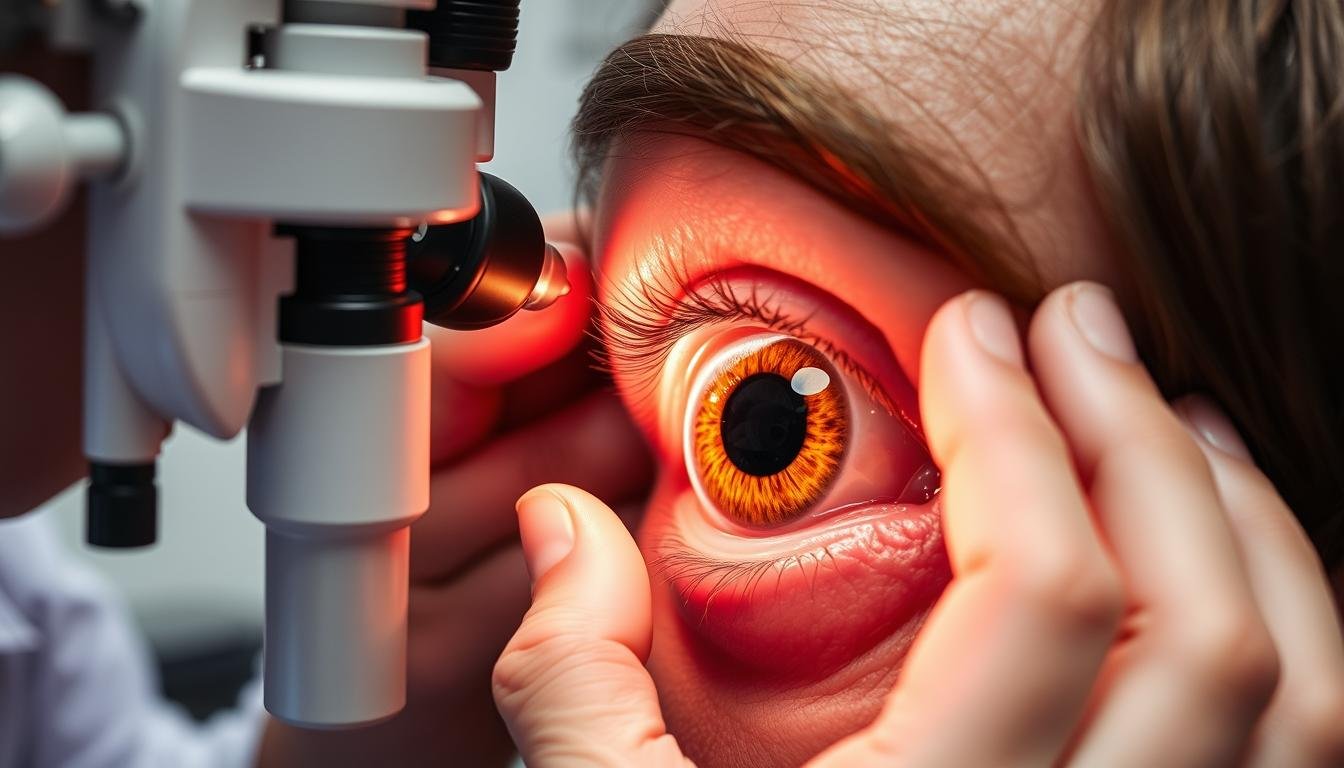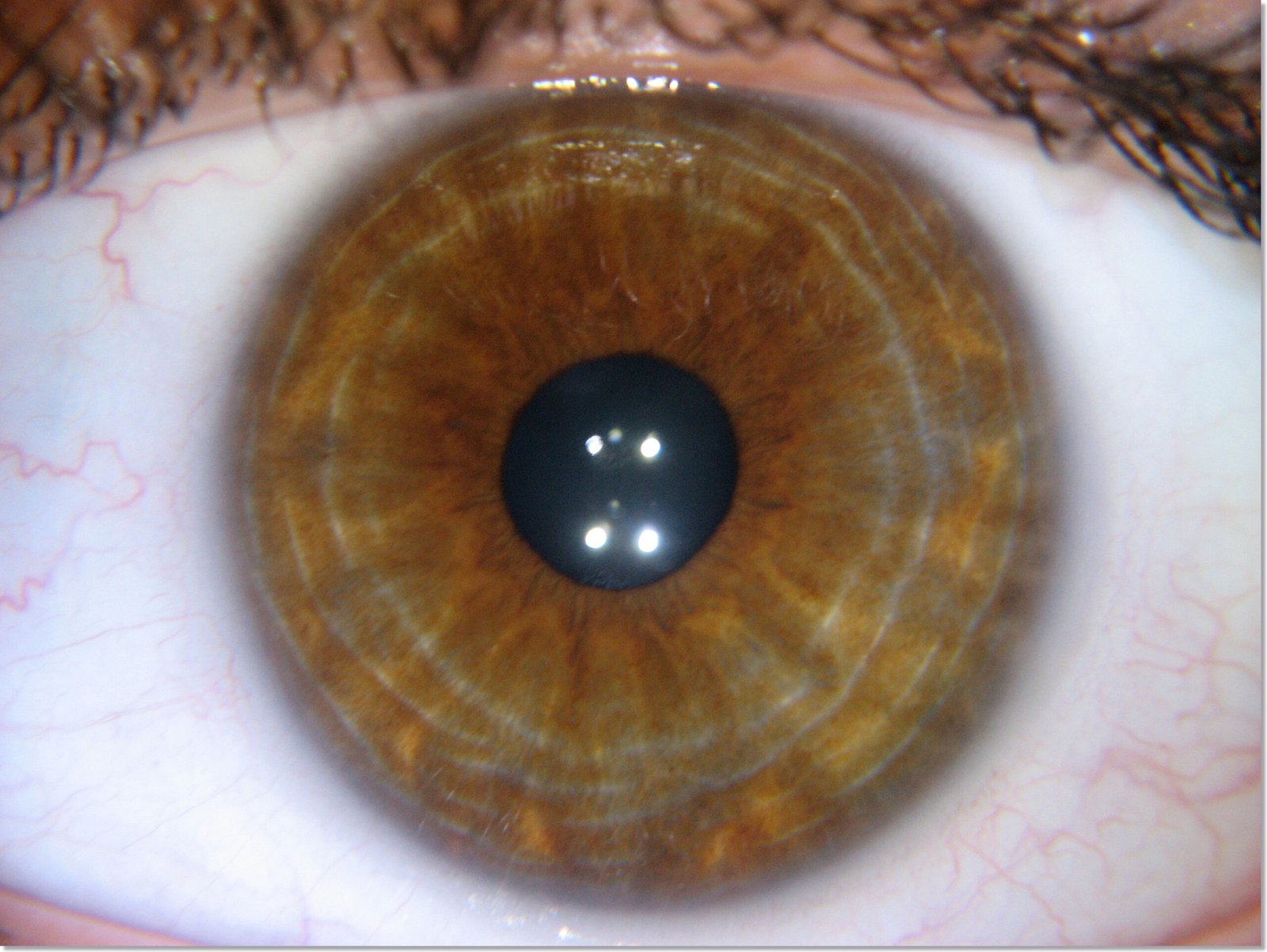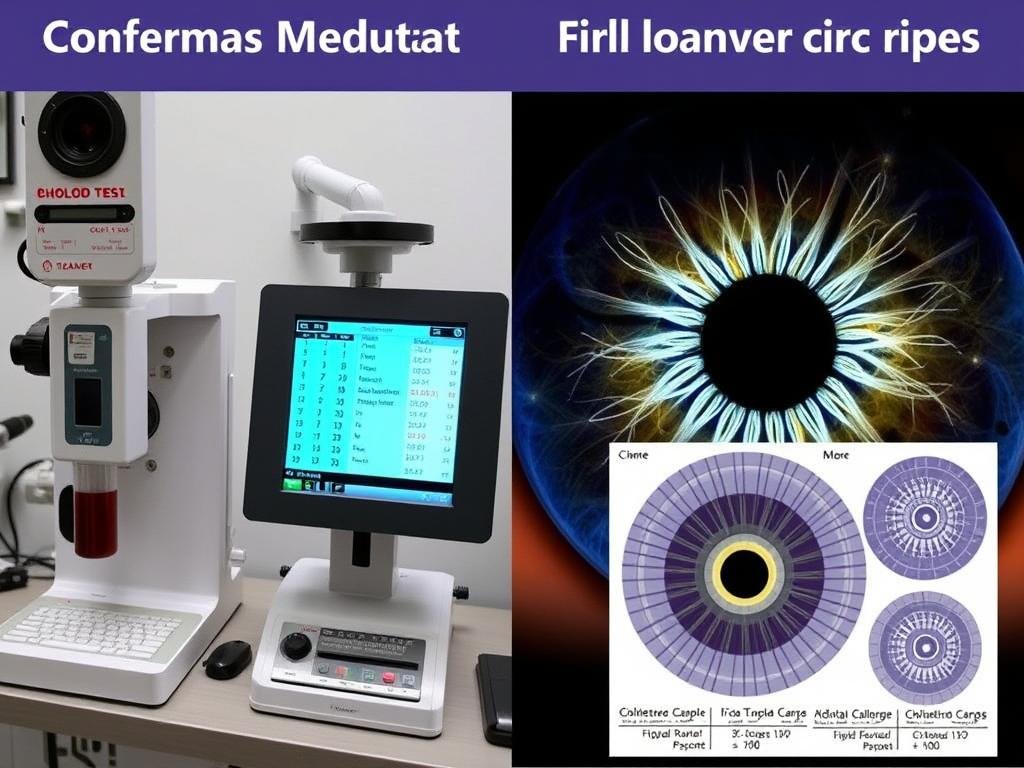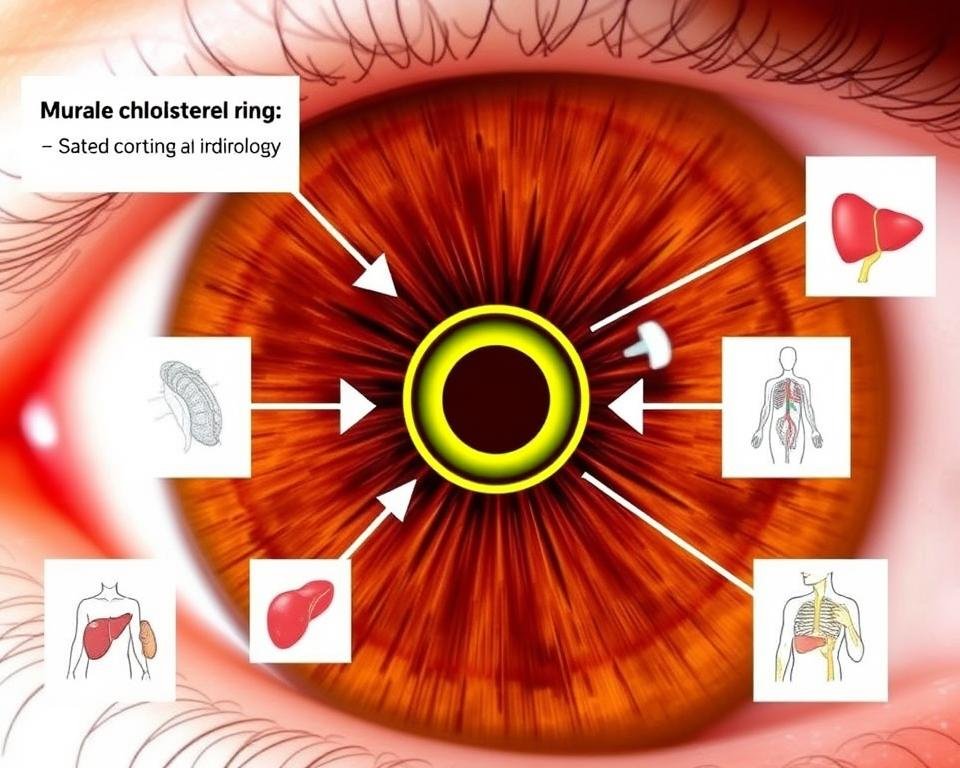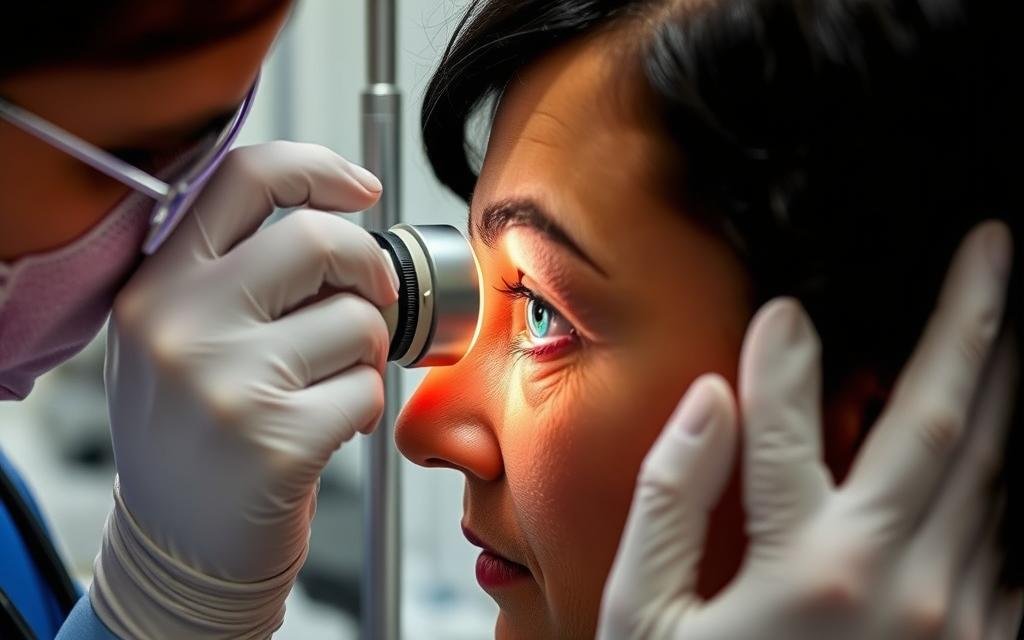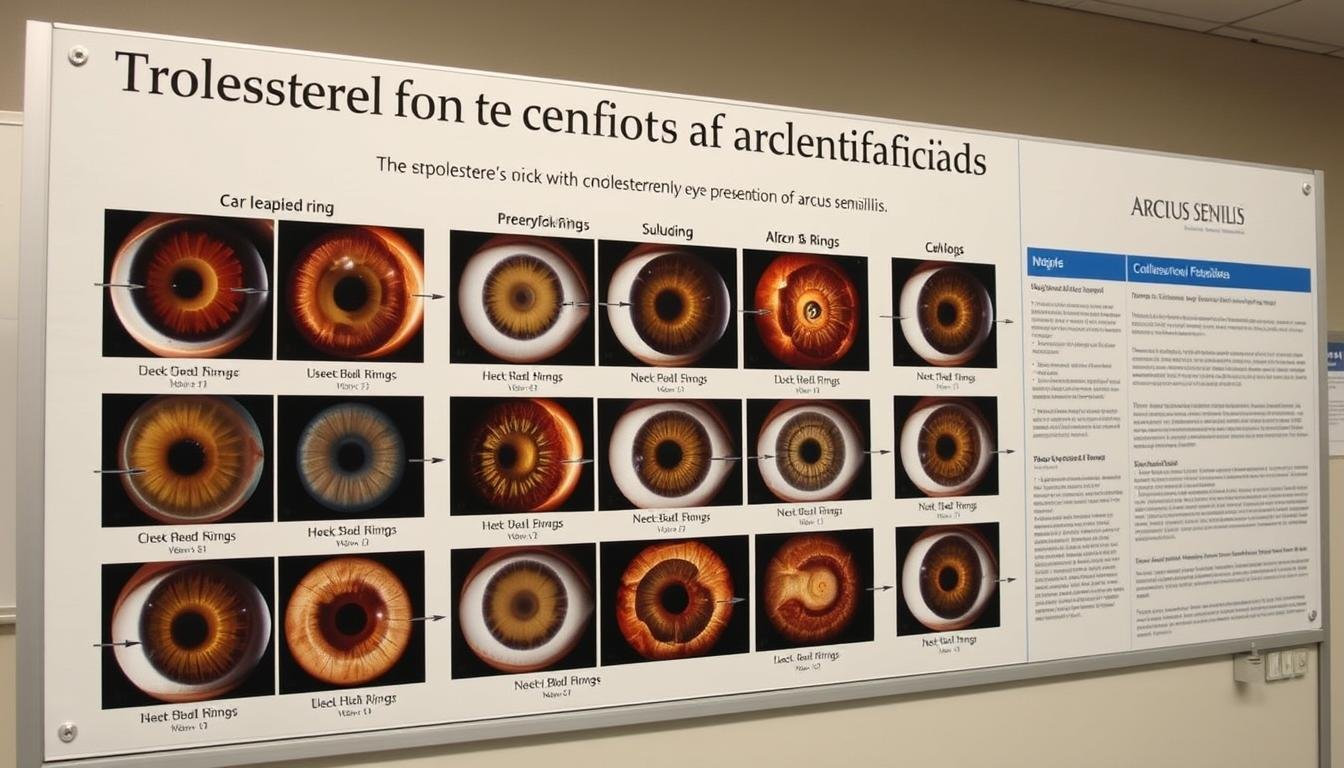ڪوليسٽرول رينگ آئرڊولوجي: ڇا توهان ڪڏهن ڪنهن جي اکين جي رنگين حصي جي چوڌاري اڇو يا گرين رنگ جو رنگ ڏٺو آهي؟ هي مخصوص خصوصيت، جيڪو iridology ۾ ڪوليسٽرول انگوزي طور سڃاتو وڃي ٿو يا طبي طور تي arcus senilis، توهان جي صحت بابت اهم معلومات ظاهر ڪري سگهي ٿي. جڏهن ته روايتي دوائون ۽ متبادل طريقا انهن انگن کي مختلف طرح سان ڏسندا آهن، اهو سمجهڻ ته اهي ڇا ممڪن طور تي ظاهر ڪن ٿا توهان جي مجموعي ڀلائي ۾ قيمتي بصيرت مهيا ڪري سگهي ٿي. هي جامع گائيڊ دريافت ڪري ٿو ته ڪوليسٽرول جا انگ ڇا آهن، انهن جي سڃاڻپ ڪيئن ڪجي، ۽ اهي توهان جي صحت بابت روايتي طبي ۽ اريڊيولوجيجي ٻنهي نقطن کان ظاهر ڪن ٿيون.Iridology ۽ Cholesterol Rings کي سمجھڻ





Iridology هڪ مريض جي صحت بابت معلومات جو تعين ڪرڻ لاءِ، اکين جو رنگدار حصو، آئرس جو مطالعو آهي. مشق ڪندڙ ايرس کي زونن ۾ ورهائيندا آهن، هر هڪ مختلف عضون ۽ جسم جي سسٽم جي نمائندگي ڪري ٿو. انهن علائقن ۾ نمونن، رنگن ۽ نشانن کي جانچڻ سان، iridologists دعويٰ ڪن ٿا ته امڪاني صحت جي مسئلن کي سڃاڻڻ کان اڳ اهي علامتون ظاهر ڪن.
هڪ ڪوليسٽرول انگو، جنهن کي روايتي دوائن ۾ آرڪس سينيليس پڻ سڏيو ويندو آهي، هڪ سفيد، سرمائي، يا نيري رنگ جي آرڪ يا مڪمل انگوزي جي طور تي ظاهر ٿئي ٿو. iridology ۾، هي انگوزي جسم ۾ ميٽابولڪ صحت ۽ ڪوليسٽرول جي سطح جي حوالي سان اهم معني رکي ٿو.
توهان جي اکين جي صحت بابت دلچسپ آهي؟
انهن نشانين کي سمجھڻ جيڪي توهان جون اکيون ظاهر ڪن ٿيون پروفيشنل رهنمائي سان. جامع اکين جي امتحانن بابت وڌيڪ سکو جيڪي ٻنهي روايتي ۽ متبادل صحت جي اشارن جو جائزو وٺي سگهن ٿيون.
سکو جامع اکين جي امتحانن بابت
ڪوليسٽرول جي چڪاس لاءِ Iris تجزيي جي سائنسي صحيحيت

کوليسٽرول انگوزي Iridology: آرڪس سينيليس ۽ ڪوليسٽرول جي سطح جي وچ ۾ تعلق روايتي دوائن پاران مخلوط نتيجن سان اڀياس ڪيو ويو آهي. طبي تحقيق تسليم ڪري ٿي ته آرڪس سينيليس - ڪارنيا جي چوڌاري سفيد يا سرمائي رنگ - اڪثر لپيد جمعن تي مشتمل آهي. 40 سالن کان گهٽ عمر وارن ماڻهن ۾، ان جي موجودگي ڪڏهن ڪڏهن اعلي ڪوليسٽرول جي سطح ۽ وڌندڙ دل جي خطري کي ظاهر ڪري سگهي ٿي.
ڊاڪٽر ايلزبيٿ يارنل، هڪ تصديق ٿيل روايتي نيچروپيٿ، وضاحت ڪري ٿي: “جڏهن ته iridology مجموعي طور تي ڪافي سائنسي تصديق جي کوٽ ناهي، آرڪس سينيليس ۽ لپيد جي خرابين جي وچ ۾ تعلق طبي ادب ۾ ڪجهه بنياد آهي. بهرحال، اهو صرف هڪ امڪاني اشارو آهي ۽ ڪڏهن به روايتي جاچ کي تبديل نه ڪرڻ گهرجي.”
سائنسي برادري عام طور تي جامع iridology کي شڪ جي نظر سان ڏسندي آهي ڇاڪاڻ ته ان جي تشخيصي دعوائن جي حمايت ڪندڙ پير صاحب جي نظرثاني ٿيل محدود تحقيق جي ڪري. هڪ 2015 جو مطالعو جرنل آف متبادل ۽ ضمني دوائن ۾ شايع ٿيل آهي خاص بيمارين کي ڳولڻ لاءِ هڪ اسٽينڊل تشخيصي طريقي جي طور تي iridology جي مدد لاءِ ڪافي ثبوت نه مليا.
ڊاڪٽر رابرٽ جانسن، اکين جي ماهر، چوي ٿو: “هڪ روايتي طبي نقطه نظر کان، جڏهن ته آرڪس سينيليس ڪڏهن ڪڏهن بلند ڪوليسٽرول سان لاڳاپو ڪري سگهي ٿو، خاص طور تي نوجوان مريضن ۾، اهو پنهنجو پاڻ تي هڪ قابل اعتماد تشخيصي اوزار ناهي. بلڊ ٽيسٽ ڪوليسٽرول جي سطح جو اندازو لڳائڻ لاءِ سون جو معيار رهي ٿو.”
اھم: Iridology کي ڪوليسٽرول جي سطح لاءِ روايتي طبي جانچ کي تبديل نه ڪرڻ گھرجي. ممڪن صحت جي حالتن جي مناسب تشخيص ۽ علاج لاءِ هميشه صحت جي ماهرن سان صلاح ڪريو.
روايتي دوائون بمقابله Iridology اپروچز کوليسٽرول مئنيجمينٽ
| پاسو | روايتي دوائون | Iridology نظريو |
| تشخيصي طريقو | رت جا امتحان LDL، HDL، ڪل کوليسٽرول، ۽ ٽرگليسرائڊس | سفيد/گرين رنگ لاءِ آئيرس جو بصري امتحان (آرڪس سينيلس) |
| پرائمري فوڪس | رت جي کوليسٽرول جي بلند سطح جو علاج | بنيادي سسٽماتي عدم توازن جي سڃاڻپ |
| علاج جو طريقو | Statins، بائل ايسڊ جي ترتيب، طرز زندگي ۾ تبديليون | غذائي تبديليون، جڙي ٻوٽين جي اضافي، detoxification |
| نگراني | ڪوليسٽرول جي سطح کي جانچڻ لاءِ باقاعده رت جا امتحان | تبديلين کي ٽريڪ ڪرڻ لاء وقتي آئرس امتحان |
| سائنسي ثبوت | وسيع ڪلينڪل آزمائشي ۽ تحقيق | محدود پير صاحب جي نظرثاني ٿيل اڀياس |
ڊاڪٽر ماريا چن، ضمني دوائن جي عملي، هڪ متوازن نقطه نظر پيش ڪري ٿي: “جڏهن ته روايتي دوائون مهيا ڪري ٿي ضروري تشخيصي اوزار ۽ ڪوليسٽرول جي انتظام لاءِ علاج، iridology ڪڏهن ڪڏهن مڪمل صحت جي نمونن ۾ مڪمل بصيرت پيش ڪري سگهي ٿي. مثالي نقطو ثبوت جي بنياد تي طبي خيال کي گڏ ڪري ٿو جسم جي سسٽم جي مجموعي شعور سان.”

Iris ۾ ڪوليسٽرول انگوزي جي سڃاڻپ ڪيئن ڪجي
کوليسٽرول رِنگز جون اهم خاصيتون
- آئرس جي ٻاهرئين ڪنڊ جي چوڌاري سفيد، سرمائي يا نيري رنگ جي طور تي ظاهر ٿئي ٿو
- عام طور تي هڪ مڪمل دائرو ٺاهيندو آهي پر شروع ٿي سگھي ٿو جزوي آرڪ جي طور تي مٿي ۽ هيٺئين پاسي کان
- هڪ تيز ٻاهرئين ڪنڊ ۽ هڪ وڌيڪ ڦهليل اندروني سرحد آهي
- وڌيڪ ڳاڙهي رنگ جي irises جي خلاف نظر اچن ٿا
- بصارت کي متاثر نه ڪندو آهي يا تڪليف جو سبب ناهي
- وقت سان گڏ وڌيڪ واضح ٿي سگھي ٿو
جڏهن ڪوليسٽرول رِنگز لاءِ آئرس جي جانچ ڪندي، مناسب روشني ضروري آهي. قدرتي ڏينهن جي روشني يا هڪ روشن سفيد روشني جو ذريعو مشاهدو لاء بهترين حالتون مهيا ڪري ٿو. انگوزي عام طور تي لمبس تي ظاهر ٿئي ٿو - رنگين آئرس ۽ اکين جي سفيد اسڪليرا جي وچ ۾ سنگم.
iridology ۾، انگوزي جي ٿلهي ۽ مڪمليت شايد ڪوليسٽرول جي عدم توازن جي شدت کي ظاهر ڪري ٿي. هڪ ٿلهي، جزوي آرڪ شروعاتي يا نرم مسئلن جو مشورو ڏئي ٿو، جڏهن ته هڪ ٿلهي، مڪمل انگوزي شايد وڌيڪ اهم خدشات ظاهر ڪري ٿي، خاص طور تي نوجوان ماڻهن ۾.
ڇا توهان ڏسي رهيا آهيو ان بابت پريشان آهيو؟
جيڪڏهن توهان محسوس ڪيو آهي ته توهان جي آئرس جي ظاهر ۾ تبديليون يا ڪوليسٽرول جي سطح بابت پريشان آهن، پيشه ورانه تشخيص جي سفارش ڪئي وئي آهي.
اکين جي سنڀال جي ماهر سان صلاح ڪريو
کوليسٽرول جي انگن جي صحت جا امڪاني اثر


ڪوليسٽرول رينگ آئرڊولوجي: هڪ روايتي طبي نقطه نظر کان، آرڪس سينيليس عام طور تي پراڻن بالغن ۾ بي نياز سمجهيو ويندو آهي. بهرحال، جڏهن اهو 40 کان گهٽ ماڻهن ۾ ظاهر ٿئي ٿو، اهو وڌيڪ تحقيق جي ضمانت ڏئي سگهي ٿو جيئن اهو ظاهر ڪري سگهي ٿو خانداني هائپر ڪوليسٽروليميا يا دل جي خطري کي وڌائي سگھي ٿو.
جڏهن هڪ ڊاڪٽر سان صلاح ڪرڻ لاء
طبي تشخيص جي سفارش ڪئي وئي آهي جيڪڏهن:
- توهان 40 سالن جي عمر کان اڳ هڪ کوليسٽرول انگوزي محسوس ڪيو
- انگوزي اوچتو ظاهر ٿئي ٿو يا تيزيء سان تبديل ٿئي ٿو
- توهان وٽ دل جي بيماري يا اعلي کوليسٽرول جي خانداني تاريخ آهي
- توهان ٻين علامن جو تجربو ڪيو آهي جهڙوڪ سينه درد، سانس جي تڪليف، يا انتهائي ٿڪڻ
- توهان وٽ موجود دل جي حالتون آهن
iridology ۾، ڪوليسٽرول جي انگن اکرن کي ظاهر ڪري سگھي ٿو وسيع ميٽابولڪ عدم توازن صرف بلند رت جي ڪوليسٽرول کان ٻاهر. مشق ڪندڙ اڪثر ڪري لاڳاپيل آئيرس جي نشانين کي ڳوليندا آهن جيڪي شايد جگر جي ڀڃڪڙي، تايرايڊ ڊيوشن، يا غريب پردي جي گردش جو مشورو ڏين ٿيون.
ڊاڪٽر ٿامس وليمس، هڪ نيچروپيٿڪ طبيب جيڪو iridology جي تربيت سان گڏ آهي، وضاحت ڪري ٿو: “منهنجي مشق ۾، مان کوليسٽرول جي انگن اکرن کي ميٽابولڪ دٻاء جي امڪاني اشارن جي طور تي ڏسان ٿو. جڏهن ته اهي اڪثر ڪري لپيد عدم توازن سان لاڳاپو رکن ٿا، اهي اهو پڻ ظاهر ڪري سگھن ٿا ته جسم ڪيتري موثر طريقي سان ٿلهي کي پروسيس ڪري ٿو ۽ فضول شين کي هٽائي ٿو. هي وسيع نظريو ذاتي زندگي جي طرز جي سفارشن جي رهنمائي ڪرڻ ۾ مدد ڪري ٿو.”

Iris تشخيص جي قابل اعتماد تي ماهر نقطه نظر
“جڏهن ته iridology ۾ تاريخي پاڙون آهن ۽ ڪيترائي سرشار عملي آهن، ان جي تشخيصي دعوائون مخصوص حالتن لاءِ جيئن ته هاءِ ڪوليسٽرول کي وڌيڪ سخت سائنسي تصديق جي ضرورت آهي. اهو چيو ته، آرڪس سينيليس جي موجودگي، خاص طور تي نوجوان مريضن ۾، طبي ڌيان جي ضمانت ڏئي ٿو جيئن اهو لپيد جي خرابين سان لاڳاپو ڪري سگهي ٿو.”
- ڊاڪٽر جينيفر مارٽنيز، ايم ڊي، اکين جي ماهر
“منهنجي 15 سالن جي iridology جي مشق ۾، مون ڏٺو آهي مسلسل نمونن جي وچ ۾ ڪوليسٽرول جي انگن ۽ ليبارٽري جي تصديق ٿيل لپڊ غير معموليات. جڏهن ته رت جي جاچ لاءِ متبادل نه آهي، آئرس تجزيي هڪ ابتدائي خبرداري واري نظام جي طور تي ڪم ڪري سگهي ٿي جيڪا مريضن کي مناسب طبي خيال ڳولڻ جي حوصلا افزائي ڪري ٿي.”
- سارا ٿامپسن، تصديق ٿيل Iridologist
“محدود ڪنٽرول ٿيل مطالعي ۽ معياري پروٽوڪول جي ڪري سائنسي برادري ڪيترن ئي iridology جي دعوائن بابت شڪ ۾ رهي ٿي. جڏهن ته، آرڪس سينيليس ۽ نوجوان آبادي ۾ دل جي خطري جي وچ ۾ رابطي کي طبي ادب ۾ ڪجهه حمايت حاصل آهي ۽ کلينياتي ڌيان جو مستحق آهي.”
- ڊاڪٽر مائيڪل چن، پي ايڇ ڊي، ميڊيڪل ريسرچ سائنسدان

هڪ پيشه ورانه تشخيص حاصل ڪريو
حيران ٿي رهيا آهيو ته توهان جي آئرس ۾ نشانيون امڪاني صحت جي خدشن کي ظاهر ڪن ٿيون؟ هڪ جامع تشخيص وضاحت ۽ ذهن جي امن مهيا ڪري سگهي ٿي.
توهان جي ويجهو اکين جو ڊاڪٽر ڳوليو
اڪثر پڇيا ويندڙ سوالن بابت ڪوليسٽرول رِنگس ۽ آئيڊيالوجي

ڇا iridology دل جي بيماري کي ڳولي سگهي ٿو؟
Iridology بذات خود دل جي بيماريءَ جي قطعي تشخيص نٿي ڪري سگھي. بهرحال، ڪجهه آئرس جون نشانيون جهڙوڪ ڪوليسٽرول رِنگز (آرڪس سينيليس) شايد دل جي خطري جي عنصر کي وڌائي سگھن ٿيون، خاص طور تي نوجوان ماڻهن ۾. هڪ iridology جي نقطه نظر کان، ٻيون iris جون نشانيون جهڙوڪ مخصوص رنگن يا نشانن جي دل جي علائقي ۾. iris چارٽ دل جي دٻاء جو مشورو ڏئي سگھي ٿو.
Cholesterol Ring Iridology: روايتي دوا اهو تسليم ڪري ٿي ته وقت کان اڳ آرڪس سينيليس (40 سالن کان اڳ) ڪڏهن ڪڏهن وڌيل دل جي خطري ۽ خانداني هائپر ڪوليسٽروليميا سان لاڳاپو رکي سگهي ٿو. بهرحال، دل جي بيماري جي صحيح تشخيص جي ضرورت آهي معياري طبي ٽيسٽ جهڙوڪ ECGs، ايڪو ڪارڊيوگرام، دٻاء جا امتحان، ۽ رت جو ڪم. Iridology مشاهدي کي صرف امڪاني اشارن جي طور تي ڪم ڪرڻ گهرجي جيڪي مناسب طبي تحقيق جي ضمانت ڏين، نه ته پاڻ کي تشخيصي اوزار طور.
ڇا پراڻو ڪمان ڦري سگھجي ٿو؟
هڪ روايتي طبي نقطه نظر کان، آرڪس سينيليس عام طور تي مستقل سمجهيو ويندو آهي جڏهن اهو فارم بڻجي ويندو آهي. لپيد جا ذخيرا جيڪي انگوزي ٺاهيندا آهن عام طور تي غائب نه ٿيندا آهن، جيتوڻيڪ رت ۾ ڪوليسٽرول جي سطح دوا يا طرز زندگي جي تبديلين ذريعي گهٽجي ويندي آهي.
ڪجھ iridology ماهرن جو مشورو ڏنو ويو آهي ته ڪوليسٽرول جي انگن جي تمام ابتدائي نشانيون شايد جارحتي طرز زندگي جي تبديلين، detoxification پروٽوڪول، ۽ غذائي علاج سان گهٽجي سگهن ٿيون. تنهن هوندي، هن دعوي جي حمايت ڪندڙ محدود سائنسي ثبوت موجود آهن. اڪثر طبي پروفيسر متفق آهن ته جڏهن توهان بنيادي کوليسٽرول جي مسئلن کي حل ڪري سگهو ٿا، ظاهر ڪيل انگوزي پاڻ کي عام طور تي رهي ٿو.
انگن جي ترقي کي روڪڻ تي ڌيان ڏيڻ گهرجي ۽ ڪنهن به بنيادي صحت جي حالتن کي خطاب ڪرڻ بجاء ان جي ظاهر کي رد ڪرڻ جي ڪوشش ڪرڻ گهرجي.
ڇا ڪوليسٽرول جي انگن اکرن کي متاثر ڪن ٿا؟
نه، ڪوليسٽرول رِنگس (آرڪس سينيليس) نظر کي متاثر نه ڪندا آهن. انهن جي ظاهر ٿيڻ جي باوجود، اهي انگوزي نظرياتي رستي يا اکين جي ڪم سان مداخلت نٿا ڪن. اهي ڪارنيا جي ڪنڊ تي واقع آهن ۽ بصري ميدان ۾ نه وڌندا آهن. اکين جا باقاعدي افعال بشمول بصري تڪڙ، پردي جي نظر، ۽ رنگ جو تصور متاثر نه ٿيو.
جيڪڏهن توهان ڪوليسٽرول انگوزي جي ظاهري سان گڏ بصري تبديلين جو تجربو ڪري رهيا آهيو، اهي امڪاني طور تي غير لاڳاپيل مسئلا آهن ۽ انهن کي الڳ الڳ اکين جي سنڀال ڪندڙ پروفيسر طرفان جائزو وٺڻ گهرجي.
ڪهڙي عمر ۾ ڪوليسٽرول جو انگ عام سمجهيو ويندو آهي؟
ڪوليسٽرول رِنگس (آرڪس سينيليس) 60 سالن کان مٿي بالغن ۾ عام عمر سان لاڳاپيل ڳولها سمجهيا وڃن ٿا. پکڙجڻ عمر سان وڌي ٿو، مطالعي مان معلوم ٿئي ٿو ته تقريبن 60 سيڪڙو ماڻهون 60 کان مٿي ۽ لڳ ڀڳ 100 سيڪڙو ماڻهو جيڪي 80 کان مٿي آهن انهن مان ڪنهن حد تائين آرڪس سينيليس پيدا ٿيندو.
جڏهن اهي انگوزي 40 کان گهٽ ماڻهن ۾ ظاهر ٿيندا آهن، انهن کي سڏيو ويندو آهي “نوجوان ڪنوار” ۽ شايد طبي تحقيق جي ضمانت ڏئي سگھن ٿيون جيئن اهي ظاهر ڪري سگھن ٿيون بنيادي لپيد جي خرابين يا وڌيل دل جي خطري کي. وچين عمر جي بالغن ۾ (40-60)، انگن اکرن واري علائقي ۾ گر ٿي ويندا آهن جتي ڪلينڪل فيصلو ۽ خانداني تاريخ اهم عنصر بڻجي ويندا آهن اهو طئي ڪرڻ ۾ ته ڇا وڌيڪ تشخيص جي ضرورت آهي.
توهان جي سمجھ کي مضبوط ڪريو
وڌيڪ ڄاڻڻ چاهيو ٿا ته توهان جون اکيون توهان جي صحت بابت ڇا ظاهر ڪن ٿيون؟ اکين جي صحت جي اشارن لاءِ اسان جي جامع گائيڊ ڊائون لوڊ ڪريو.
مفت اکين جي صحت گائيڊ ڊائون لوڊ ڪريو
نظريو توازن: صحت جي تشخيص ۾ ڪوليسٽرول انگوزي جو ڪردار

آئرس ۾ ڪوليسٽرول جي انگن اکرن کي روايتي دوا ۽ متبادل صحت جي طريقن جي وچ ۾ هڪ دلچسپ چونڪ جي نمائندگي ڪري ٿو. جڏهن ته iridology جي وسيع دعوائون سائنسي حلقن ۾ بحث جاري آهي، arcus senilis ۽ امڪاني دل جي خطري عوامل جي وچ ۾ مخصوص ڪنيڪشن ٻنهي دنيان ۾ ڪجهه تسليم ڪيو آهي.
هڪ متوازن طريقي سان آئرس تجزيي جي حدن کي تسليم ڪري ٿو جڏهن ته ان جي امڪاني ڪردار کي تسليم ڪندي ڪيترن ئي صحت جي اشارن مان هڪ آهي. انهن لاءِ جيڪي iridology ۾ دلچسپي رکن ٿا، اهو بهترين طور تي ڏٺو وڃي ٿو هڪ مڪمل اوزار جي طور تي جيڪو مناسب طبي تحقيق کي تيز ڪري سگهي ٿو بجاءِ اسٽينڊل تشخيصي طريقي جي طور تي.
ڇا توهان هڪ روايتي يا متبادل نقطه نظر کان ڪوليسٽرول جي انگن اکرن ڏانهن وڃو، اهي جسم جي باضابطه فطرت ۽ جامع صحت جي تشخيص جي قدر جي ياد ڏياريندڙ طور ڪم ڪن ٿا. مناسب طبي خيال سان ڪيترن ئي صحت جي روايتن مان بهترين بصيرت کي گڏ ڪرڻ سان، توهان پنهنجي جسم جي سگنلن جي وڌيڪ مڪمل سمجھ کي ترقي ڪري سگهو ٿا ۽ بهتر صحت جي طرف مناسب قدم کڻندا.
توهان جي صحت جي سفر ۾ ايندڙ قدم وٺو
ڪوليسٽرول جي انگن يا ٻين اکين جي صحت جي اشارن بابت ڳڻتي آهي؟ پيشه ورانه ھدايت توھان جي مدد ڪري سگھي ٿي انھن نشانين جي تشريح ڪرڻ ۽ ھڪ مناسب صحت جو منصوبو ٺاھيو.
اڄ هڪ مشاورت جو وقت مقرر ڪريو

